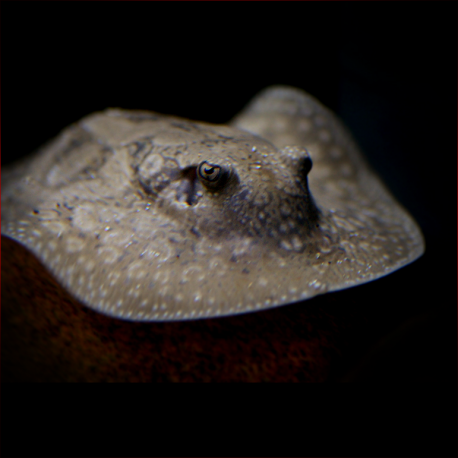More info
Datasheet
| Minimum Tank Size | 650 litres / 171.71 US gallons |
| Maximum Size | 50.0cm / 19.69inches |
| Temperature | 24°C / 75.20°F - 26°C / 78.80°F |
| Hardness | 5-10ºdH |
| pH | 6.0-7.0 |
Behaviour
Rays are apex predators in their natural ecosystems, known for their dangerous sting located on the top of their caudal fin, which can cause intense pain and tissue degeneration. While not inherently aggressive, rays use their sting as a defense mechanism and can become quite tame in home aquariums. Tank mates should be carefully selected to be large enough not to be eaten, peaceful, and ideally, occupy the upper parts of the tank. Some suitable companions include cichlids, larger characins, Asian or South American arowana, and bichirs. (see table)
Feeding and Diet
In the wild, rays primarily feed on other fish, aquatic invertebrates, worms, and crustaceans. Rays have high metabolic rates and need to be fed at least twice a day with a predominantly meaty diet. Live or frozen foods like bloodworms, Artemia, krill, mussels, prawns, and earthworms are suitable for their diet. Feeder fish like livebearers or small goldfish should be avoided due to potential disease risks. Rays may initially be reluctant to accept food when imported, so feeding them live foods until they can transition to dead alternatives is crucial for their health.
Reproduction & Dimorphism
Potamotrygon species exhibit matrotrophic viviparity, giving birth to fully-formed pups after a gestation period of months. Rays can be picky about selecting mates, and successful breeding can take time. Males are easily identifiable by their claspers, while females typically mate with larger males. Courtship and mating behaviors can be violent, emphasizing the need for proper monitoring during breeding. Gestation usually takes around 9-12 weeks, with pups requiring high-quality live and frozen foods after birth.
Habitat and Distribution
Porcupine Stingrays, like other Potamotrygon species, inhabit a variety of biotopes in South America, including sand banks, major rivers, tributaries with mud or sand substrates, and flooded forests during wet seasons. They can also be found in terrestrial lakes and ponds formed by receding floodwaters. These rays are primarily found in the Rio Paraná and Rio Paraguay basins in Argentina and Brazil.
Aquarium Setup
When setting up an aquarium for rays, ensure a spacious tank of at least 650 liters with minimal decor but secure, heavy items like bogwood or rocks. Substrates like river sand or gravel can be used, or substrate can be omitted. Filtration is crucial, preferably a sump-type setup or external canister filters to manage waste from these active, predatory fish. Regular water changes, stringent maintenance, and careful observation during feeding are essential to ensure the well-being of rays in captivity.

